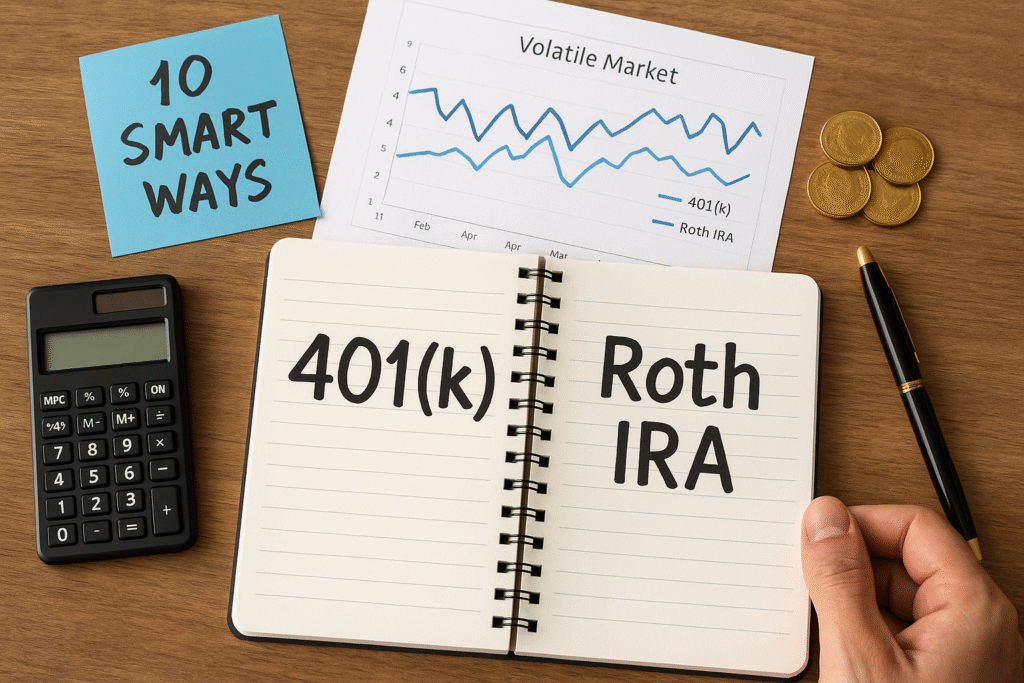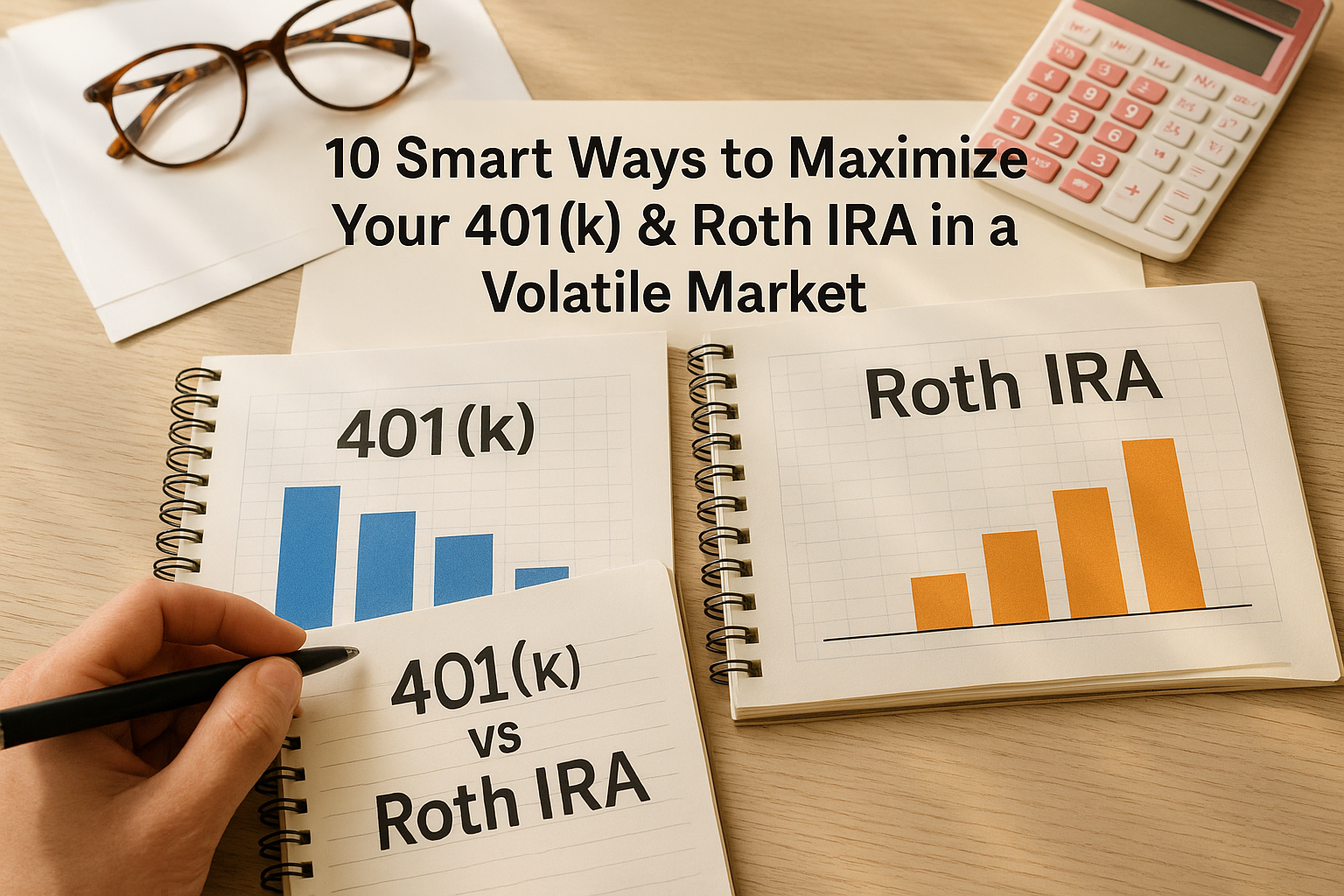401k vs Roth IRA: Volatile markets make retirement planning feel stressful — but the right game plan turns volatility into opportunity. This practical, step-by-step guide explains how to use both your 401(k) and Roth IRA together, how to get the full employer match, how recent rule changes affect you (SECURE 2.0, contribution limits, RMDs), and simple allocation tactics you can use today — all using official U.S. government sources.
Quick snapshot — what this post covers
- Key 2025 numbers you need to know (contribution & catch-up limits, Roth income phase-outs). (IRS)
- Why you should usually max the employer match first. (DOL)
- Practical allocation strategies for volatility (age-based and goal-based).
- Roth vs traditional (tax timing, RMDs, conversions, rollovers). (IRS)
- Actionable checklist you can implement this month.
- Authoritative government links (verified and live as of August 17, 2025) for further reading and to cross-check rules.
1) Start with the rules (the numbers that matter in 2025)
- 401(k) elective deferral limit (employee pre-tax or Roth 401(k)) for 2025: $23,500. The overall combined employer + employee annual contribution limit into a participant’s account is higher (see IRS guidance). SECURE 2.0 also changed some catch-up rules for older workers. (IRS)
- Roth IRA / Traditional IRA contribution limit for 2025: $7,000 (under 50) and $8,000 (age 50 or older, including the $1,000 catch-up).** Roth IRA eligibility phases out at higher incomes — for 2025 the Roth phase-out is roughly $150,000–$165,000 (single) and $236,000–$246,000 (married filing jointly) — check your MAGI rules. (IRS)
- Required Minimum Distributions (RMDs): SECURE 2.0 raised the RMD starting age to 73 and establishes a later increase to 75 by 2033 for certain birth years — Roth IRAs remain exempt from lifetime RMDs. If you want to delay taxes in retirement, this matters. (IRS)
(These are the official limits from IRS/DOL sources — check the IRS pages in the Resources section below for the latest numeric updates and plan-specific details.)
2) Priority funnel: the order I recommend (simple rule)
- Get the employer match in your 401(k) — at a minimum. Employer match = instant guaranteed return (it’s free money). Plans differ (matching formulas vs nonelective), so check your plan’s SPD or ask HR. (DOL)
- If you still have room and expect higher income tax later → prioritize Roth (Roth 401(k) or Roth IRA). Roth grows tax-free and qualified withdrawals are tax-free (helpful if you expect higher future rates). (IRS)
- If you need current tax relief, prioritize traditional 401(k) (pre-tax) or deductible traditional IRA.
- Max out IRAs (Roth or Traditional) next — you can’t exceed the $7k/$8k combined IRA cap. (IRS)
- If you still have money left to save, up your 401(k) deferral up to the $23,500 (and catch-up if eligible). (IRS)
Why this funnel? Employer match first, then tax diversification and IRAs for flexibility. Roth assets give you tax-free withdrawal optionality in retirement; traditional accounts reduce taxable income today.
3) Employer match tactics (how to squeeze every cent)
- Contribute at least to the match: If your company matches 50% of the first 6% you put in, contribute 6% immediately — failing to do so is leaving guaranteed returns on the table. The DOL explains how matching formulas and nonelective contributions work. (DOL)
- If you can’t afford the full % right away, use a ramp plan: Increase your deferral by 1%–2% each paycheck or annually. Many 401(k) plans allow changes online. SECURE 2.0 also promotes automatic enrollment/auto-escalation for new plans — check whether your employer’s plan automatically enrolls and what the escalation schedule is. (IRS, DOL)
- Watch vesting schedules: Employer contributions often vest over time. If you might change jobs, understand how much of that match you actually keep. Your plan’s Summary Plan Description will show the vesting schedule. (IRS)

4) Asset allocation in a volatile market — two practical approaches
A. Age-based (simple, low-maintenance)
- Rule of thumb: Target-date style allocation or “100 (or 110) − your age = % in stocks.” For example, age 40 → 60–70% stocks, remainder bonds/cash. Adjust the equity mix depending on risk tolerance.
- Rebalance once or twice a year to keep allocations on track (auto-rebalance features in many 401(k)s help).
B. Goal-based with buckets (more tactical)
- Bucket 1 — Short term (0–5 years): Cash, short-term bonds, or plan’s stable value fund for near cash needs. Avoid high equity exposure for money you may need soon.
- Bucket 2 — Medium term (5–15 years): Blend of dividend/quality stocks and intermediate bonds.
- Bucket 3 — Long term (15+ years): Higher equity tilt — you have time to ride out volatility. Consider low-cost index funds/ETFs inside your 401(k) or IRA.
Practical steps for volatility
- Use dollar-cost averaging (regular payroll contributions) — you automatically buy more shares when price dips.
- Keep emergency savings outside retirement so you don’t have to withdraw in a down market (retirement accounts may hit taxes/penalties if withdrawn early).
- Consider adding a small allocation to low-cost global/international ETFs for diversification inside your IRA/401(k).
5) Roth vs Traditional — when to prefer each (and how to blend them)
- Choose Roth if: you expect your tax rate in retirement to be higher than today, you want tax-free withdrawals, or you want to avoid RMDs in Roth IRA form. Roth 401(k) lets you have Roth within your employer plan; Roth IRAs provide more withdrawal flexibility. (IRS)
- Choose Traditional if: you want the current tax deduction (reduces taxable income now) or you’re in a high tax bracket today.
- Blended approach: Many savers split contributions (e.g., 60% traditional, 40% Roth) to hedge tax-rate uncertainty — it gives you tax diversification in retirement.
Conversions (Traditional → Roth)
- Converting a traditional IRA/401(k) to Roth triggers taxable income for the converted amount. The IRS rules limit recharacterizations (you can’t recharacterize a conversion back to traditional). Plan conversions carefully and consult the IRS guidance and Publication 590-A for contribution/conversion rules. (IRS)
6) Rollovers, one-year IRA rollover rule, and taxable events — what to watch
- If you roll distributions from an IRA to another IRA, you can generally do only one such 60-day rollover per 12-month period across all IRAs. Direct rollovers (trustee-to-trustee) between plans or to an IRA avoid this trap and avoid mandatory withholding. Use direct rollovers to move 401(k) money to an IRA or a new employer plan smoothly. (IRS)
7) SECURE 2.0 — recent changes that affect your decisions
- Automatic enrollment & escalation: Newer employer plans are generally required to automatically enroll eligible employees at a starter rate and escalate contributions up to a cap (these rules are rolling out and subject to proposed regs). This makes saving easier for many workers. (IRS)
- Higher catch-ups for some older workers: SECURE 2.0 expanded catch-up options for people aged 60–63 in some plans starting in 2025. If you’re in that age band, you may be able to contribute more to your employer plan. (Fidelity)
- Lost & Found database: DOL is creating searchable tools to help savers find old accounts (great if you’ve changed jobs a lot). (DOL)
Because SECURE 2.0 added many plan-level and timing details, check your plan documents and DOL/IRS guidance before making plan changes.

8) Tax & withdrawal rules you must not forget
- Early withdrawals (before 59½) may face a 10% penalty plus ordinary income tax unless you meet an exception. Roth contributions (not earnings) can often be withdrawn penalty-free from a Roth IRA. Check IRS Topic 451 and Publication 590-A for exceptions, ordering rules, and penalties. (IRS)
- Roth IRAs have qualified withdrawal rules (account must be 5 years old and withdrawal age/conditions met) for earnings to be tax-free. See IRS guidance for the 5-year rule and ordering rules. (IRS)
9) Actionable checklist — what to do this month
- Open your plan portal: Confirm your current 401(k) deferral %, employer match formula, and available funds. (HR or your plan’s SPD will have the match/vesting info.) (IRS)
- At a minimum: set deferral to capture full employer match.
- If eligible, open a Roth IRA at a low-cost custodian and set up a recurring monthly SIP up to the IRA limit (remember combined IRA limit of $7k/$8k). (IRS)
- Set a simple allocation (e.g., target-date fund or 70/30 equity/bond for long-term savers) and enable automatic rebalancing if available.
- If you’re age 50+ or near 60, verify catch-up rules and whether your plan allows the higher SECURE 2.0 catch-up. (Fidelity)
- Document rollovers: use direct rollovers when changing jobs to avoid 60-day/one-per-year IRA rollover pitfalls. (IRS)
- Bookmark the IRS and DOL links below and review them yearly or when you change employers.
10) FAQs (short & sharp)
Q: Should I choose Roth 401(k) or Roth IRA?
A: Use a Roth 401(k) if you want higher contribution room within a workplace plan; use a Roth IRA for more flexible withdrawals and tax diversification if your income makes you eligible. Check the IRA phase-out rules before opening a Roth IRA. (IRS)
Q: Can I contribute to both a 401(k) and an IRA?
A: Yes. You can contribute to both, but IRA tax deductibility and Roth eligibility depend on income and whether you’re covered by a workplace plan. See IRS Publication 590-A. (IRS)
Q: What if my employer offers Roth and Traditional 401(k) options?
A: Consider splitting to get tax diversification. Also confirm whether employer match goes into a pre-tax account (most matches are pre-tax, even if you choose Roth deferrals).
Final thoughts (short)
In a volatile market the best advantage you have is discipline: capture the employer match, use steady payroll contributions (dollar-cost averaging), keep an emergency fund outside retirement, and build tax diversification with Roth and traditional accounts. Use the official IRS and DOL links below for exact numbers, forms, and plan rules — and check them every year or when your employment status changes.
Authoritative government resources (verified live on August 17, 2025)
Use these pages for exact rules, forms, and plan-specific guidance (all links were checked and were active as of Aug 17, 2025):
- IRS — 401(k) limit increases to $23,500 for 2025; IRA limit remains $7,000 (newsroom):
https://www.irs.gov/newsroom/401k-limit-increases-to-23500-for-2025-ira-limit-remains-7000 (IRS) - IRS — Retirement Topics — IRA Contribution Limits (overview of IRA limits and eligibility):
https://www.irs.gov/retirement-plans/plan-participant-employee/retirement-topics-ira-contribution-limits (IRS) - IRS — 401(k) and Profit-Sharing Plan Contribution Limits (detailed limits & catch-up info):
https://www.irs.gov/retirement-plans/plan-participant-employee/retirement-topics-401k-and-profit-sharing-plan-contribution-limits (IRS) - IRS — Traditional and Roth IRAs (Tax treatment, qualified distributions, 5-year rule):
https://www.irs.gov/retirement-plans/traditional-and-roth-iras (IRS) - IRS — Rollovers of retirement plan and IRA distributions (direct rollovers and one-per-year rollover rule):
https://www.irs.gov/retirement-plans/plan-participant-employee/rollovers-of-retirement-plan-and-ira-distributions (IRS) - IRS — Retirement plan & IRA Required Minimum Distributions (RMD) FAQs (start ages and rules):
https://www.irs.gov/retirement-plans/retirement-plan-and-ira-required-minimum-distributions-faqs (IRS) - U.S. Department of Labor — Employee Benefits Security Administration (EBSA) (plan participant resources & SPD guidance):
https://www.dol.gov/agencies/ebsa/about-ebsa (DOL) - U.S. Department of Labor (EBSA) — 401(k) Plans for Small Businesses (matching & plan design help):
https://www.dol.gov/agencies/ebsa/about-ebsa/our-activities/resource-center/publications/401k-plans-for-small-businesses (DOL) - U.S. Department of Labor — Field Assistance Bulletin & SECURE 2.0 guidance (example):
https://www.dol.gov/agencies/ebsa/employers-and-advisers/guidance/field-assistance-bulletins/2025-01 (DOL) - IRS — Publication 590-A (Contributions to IRAs) (detailed, official rules on contributions and conversions):
https://www.irs.gov/publications/p590a (IRS)
Disclaimer
This blog post is for informational purposes only and does not constitute tax, legal, or investment advice. Rules and dollar limits change; consult the IRS, DOL, your plan administrator, and a qualified tax or financial advisor before making major retirement decisions. Links above point to official U.S. government pages (IRS and DOL) where you can confirm rules and find forms. All images used in this article are royalty‑free or licensed for commercial use and are provided here for illustrative purposes.
